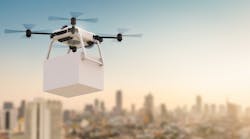The “last mile” is a confusing place for procurement professionals, supply chain managers, and entire organizations, all of which have been scrambling to figure out how to get orders from the last distribution point to the final destination in the most efficient, expedient manner possible.
Making that happen isn’t easy. Defined as the movement of goods from a transportation hub to a final destination, the last mile presents a unique set of challenges compared to the rest of the supply chain, according to VDC Research’s Richa Gupta, author of From the Last Mile to the Last Meter.
“Packages often do not reach their intended recipient on the first delivery attempt, resulting in items being returned to distribution center hubs,” she points out. “This translates into increased costs for delivery service providers and reflects poorly on sellers, resulting in pronounced consumer dissatisfaction.”
The Race Is On
And so, the race to shorten the last mile is on. With an ever-growing volume of e-commerce sales, consumers, retailers, and parcel service providers have all come to realize the glaring inefficiencies in this sector of the supply chain. “Explosive growth in the use of non-traditional retail avenues has exacerbated and exposed an already existing issue,” Gupta concludes. “This is also a huge cost component of the supply chain, representing an estimated 28% of the cost of delivery.”
Some companies are already making headway on this issue, and coming up with ways to close the last-mile gaps that exist within their supply chains. In April, for example, Amazon began eyeing driverless car technology as a way to get items delivered faster.
“Amazon.com has created a team focused on driverless-vehicle technology to help navigate the retail giant’s role in the shake-up of transportation,” SupplyChain247 reported. “The initiative, still in its early phases, could help the Seattle-based company overcome one of its biggest logistical complications and costs: delivering packages quickly.” In addition, the publication notes that driverless cars could play a broader role in the future of last-mile delivery, enabling easier package drop-offs.
“The self-driving car team may be part of an effort by Amazon to take greater control of its supply chain,” writes Stephen Edelstein in The Drive. “The company currently relies on third parties to do most of the delivery and shipping work. And yes, self-driving cars could be linked to the drone-delivery program, which is reportedly still being pursued by Amazon.” (Amazon is currently experimenting with drone delivery service that could change the way the supplier—and others—addresses its last-mile challenges.)
Lower Shipping Costs
One area where driverless vehicles and drones could have a significant impact is shipping costs. That’s because not only could self-driving cars be used to deliver packages to customers during the final leg (i.e., the “last mile”) of the shipping process, but companies like Amazon and others could use autonomous cars, trucks, forklifts, and drones to move goods in and around warehouses and elsewhere.
“Shipping and delivery costs continue to rise for Amazon as it delivers more categories of products,” writes Valentina Palladino in “Amazon might use driverless vehicles to deliver packages in the future.”
“Autonomous vehicles could cut those costs, especially considering that they don't have the same time restrictions that humans do,” Palladino continues. “Humans, specifically truck drivers, have a 10-hour limit before they need to stop for rest. A shipment that originally took a few days to move across the country in a human-driven vehicle could take half the time with a self-driving car.”
Flying Deliveries?
So will we start seeing those electronic components delivered via unmanned vehicles and/or drones in the near future? Most of the technology behind the mission is already in the development and/or testing stages, but human adoption and acceptance of the delivery modes could be the biggest stumbling blocks.
“The usual history is people are pretty content with what they know, what they have, and adopting an innovation does take substantial effort,” said Ben Shneiderman, an expert on human-computer interaction at the University of Maryland, told The Washington Post. “The question becomes, ‘Which are innovations that may be more acceptable to people, and how might a manufacturer accelerate adoption?’”










